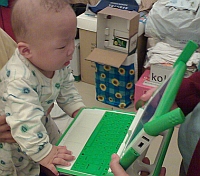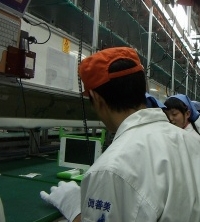Hardware suppliers have been given the green light to ramp-up production of all of the components needed to build millions of the low-cost machines. Previously, the organisation behind the scheme said that it required orders for 3m laptops to make production viable.The BBC article hedges on two points - the magnitude of the order and who's buying. It hints at the 3 million number, but previous statements are not solid numbers, as we've bounced around 5 and 10 million laptop order numbers not that long ago. Reuters via eWeek coverage provides a more solid number and more insight into the need for the commercial market to buoy the development market:
Foundation executives have previously said that they didn't intend to commercialize the product this year as they wanted to focus their energy on serving the educational market in developing countries.I thought the goal was to maximize the global education revolution, not "units shipped"? Regardless, that "previously" word appears again, but we get a solid statement (at least, after Reuters revised the article) of the 3 million unit number. This doesn't seem to be meshing with the reality experienced by Quanta's upstream parts providers, indicating that the initial production run may be one million (or fewer!) units. Steve Shen in digitimes (login may be required) reports on Quanta's orders for the third-party parts needed for the OLPC (emphasis mine):But now they are evaluating whether it makes sense to quickly move into the commercial market, using profits from those sales toward the cost of making laptops for poor children, Jepsen said.
"Our whole goal is to maximize the number of units shipped," she said. She talked about plans for commercializing the product on Monday as the foundation said it has formally authorized mass production of the device to begin in October, with an original order of some 3 million machines.
Shipment targets of OLPC (One Laptop Per Child) notebooks from Quanta Computer and the Eee ultra-low-cost notebooks from Asustek Computer for this year could both be revised downward, with Quanta likely to ship less than one million OLPCs, and Asustek only delivering 200,000-300,000 Eee PCs for all of 2007, according to a Chinese-language Commercial Times report.With potentially only one million laptops on the table, how will the distribution among the countries fall out? This is the second dodge the BBC fails to get specific on. Their article mentions more than once that "The organisation has not said which countries have bought the first machines," despite a pretty clear mapof which countries are currently lined up for ... piloting:Quanta has begun placing orders for needed parts and components with downstream suppliers but with the ordered quantities falling far short of expectations
GreenHowever, official OLPC announcements from governments are limited and noncommittal, nothing more solid than Libya's MOU, which has already been scaled back. Argentina, Brazil, Nigeria, Rwanda and Uruguay have all stated intentions to have OLPC projects.
those countries we plan to pilot:
Argentina, Brazil, Ethiopia, Libya, Nepal, Nigeria, Pakistan, Peru, Romania, Russia, Rwanda, Thailand, Uruguay & USA
(from the OLPC Wiki Map)
Romania, while still listed as green on the map, has declined the OLPC laptops, and there don't seem to be any solid plans for the USA projects.
If the 1 million unit number is accurate, obviously no country went for the original minimum 1 million unit order, and only 4 out of the 6 most likely countries could be involved if they each were taking the most recent 250,000 unit minimum. One wonders if these and the other green/interested countries are planning actual pilot programs with initial orders under the 250,000 minimum? That would truly be an Christmas implementation miracle.




"I thought the goal was to maximize the global education revolution, not "units shipped"?"
These goals might be related in some way.
digitimes: "Quanta likely to ship less than one million OLPCs,"
But was that figure from before oplc announced it was going to sell commercially? I think that could easily add another million.
And remember that Intel is supporting the launch:
http://www.linux.com/feature/118185
Patrick, "These goals might be related in some way" - I disagree. In development projects you want depth, not breadth, to improve project sustainability. If you're just trying to churn out as many computers and sign up as many governments as possible, you lose that.
Eduardo: This was announced in conjunction with the the USA commercial sales, and probably buoyed by their projections.
As soon as OLPC watered down the original one million order limit the die was set (or is that dye?).
No government will commit to having to buy one million (or more) of an unknown product with no implementation plan. Most have opted for small scale deployments to test the water.
Now we see production estimates scaled down due to several factors, not the least of which has been created by OLPC themselves. Negroponte has played the Entrepreneur card and been slapped in the face. Dealing direct with Governments is difficult at any stage and country leaders are more likely to shake hands than write checks for $175 Million.
Quanta want big orders. Making a run of one million XOs is hardly going to make them cheaper and could in fact see the production cost be greater than the return on selling them.
No wonder they are talking now about retail channels.
"Patrick, "These goals might be related in some way" - I disagree."
I agree with Patrick. The OLPC educational project cannot start if the XO is too expensive. Even the $176 price tag is only possible in batches of millions. And price, ie, risk to implementer, was one of the biggest obstacles to start distribution.
So indeed, to get the educational project off the ground, the OLPC needs a lot of orders. Adding commercial orders will fit the bill.
Btw, the OLPC development will grind to a halt if they cannot get a real roll-out.
Winter
There is no contradiction between commercial sales of oplc and its educational goals. Computers have been used in education for a couple of decades, and they have all been models that were also sold commercially.
Robert Arrowsmith:
"Negroponte has played the Entrepreneur card and been slapped in the face."
Huh? You mean all those countries were set to order, but then they canceled their orders when Negroponte announced commercial sales?
"No government will commit to having to buy one million (or more) of an unknown product with no implementation plan."
All the more reason to go commercial, because commercial success increases credibility.
jon:
"Eduardo: This was announced in conjunction with the the USA commercial sales, and probably buoyed by their projections."
I find that hard to believe. The laptop market this year is projected to be 97 million. It is hard for me to believe that commercial sales alone would not add up to at least a million, given the X0's unique strengths.
Anyway, let's remember that oplc is already a big success in that it has pushed several commercial oem's to develop full-function computers designed for the developing world, something they had up til now avoided doing.
If they start selling XO boxes commecially shouldn't they at least be in a different color?
It would seem that by retailing green OLPC laptops it justifies selling laptops that are stolen from children and sold on the black market.
I'm all for laptops in, say a black case that are obviously not the pre-loved favorite toy of a south american child.
The mass production has to start with around 40 thousand units the first month, 400 thousand units the second month and then 1 million units a month afterwards. This was previously said by Michail Bletsas of OLPC in some interview. Quanta cannot ramp up mass production at 1 million units per month from the first month. I'm not a mass production specialist, but I guess it can have something to do with reliabillity of manufacture and extensive testing of the mass manufacturing hardware before risking to produce a batch of a million faulty units.
So components are being shipped now, but first mass produced laptops are to be delivered in October. So logically it'll be 40 thousand units in October, 400 thousand in November, maybe one million in December and then a million more each month in the beginning of 2008, so by the end of 2008 there should be over 10 million XO-1 units in the hands of Children with final developments and testing of XO-2 (with or without an Intel processor inside) being made to be I guess mass manufactured by the end of 2008.
"so by the end of 2008 there should be over 10 million XO-1 units in the hands of Children with final developments and testing of XO-2 (with or without an Intel processor inside) being made to be I guess mass manufactured by the end of 2008."
Sounds great.
But who exactly do you think is paying the required $1-1.5B?
Winter
About 50 developping and developped countries, and a bunch of good PR seeking philanthropists like the richest guy in the world Carlos Slim Helu, Bill Gates once he is out of Microsoft and Google and others probably will gladly like to put a billion each into spreading 10 million hundred dollar laptops each. For a billion dollars, you get 10 million hundred dollar laptops, that's like nearly twice the population of Denmark of kids getting a laptop. Each donor may I guess have their logo sticker on the laptop thus "Intel Inside", "Google" or "Telmex" could be stickers on the front of those laptops. Sponsoring a childs education for 100 bucks is probably something the investors will understand if company money is spend on, as partly long-term marketing (those kids could grow up buying Intel products, use Google and buy a mobile phone with Telmex.) Etc. But each country even the poorest countries have more than enough to invest in a laptop per child. It just has to be proven to work, I think it already has, but for sure the proofing of concept is far from being complete and the concept itself has a lot around it (software, strategy, technics, content..) to be invented and implemented.
Aside the $180 price tag, one of the key problems in the XO design is that the architecture falls behind the optimal price curve. In high-tech world, older parts are not necessarily cheaper today.
I love the concept of helping kids with available technologies. But XO's development took too long. As the time window phased out, the XO is pretty much a piece of "eJunk" today (sorry for the bad term). People here in California are throwing Pentium 3 boxes (that's what XO was designed on) into e-Recycle dumpsters.
I think the OLPC needs to re-think the strategy with a dynamic architecture to capture the "sweat spot" in order to be cost effective.
Otherwise, why need to "manufacture" the machines that was three generations behind technology in the first place? There are millions of Pentium 3 machines out there collecting dust.
I am looking for parts to make beginning production laptops in Poland
contact me masza66@mail.ru
Marina Kennedy